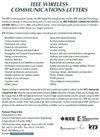Capacity Maximization for Base Station With Hybrid Fixed and Movable Antennas
IF 4.6
3区 计算机科学
Q1 COMPUTER SCIENCE, INFORMATION SYSTEMS
引用次数: 0
Abstract
Six-dimensional movable antenna (6DMA) is an effective solution for enhancing wireless network capacity through the adjustment of both 3D positions and 3D rotations of distributed antenna surfaces. Although freely positioning/rotating 6DMA surfaces offer the greatest flexibility and thus highest capacity improvement, its implementation may be challenging in practice due to the drastic architecture change required for existing base stations (BSs), which predominantly adopt fixed-position antenna (FPA) arrays (e.g., sector antenna arrays). Thus, we introduce in this letter a new BS architecture called hybrid fixed and movable antennas (HFMA), which consists of both conventional FPA arrays and position/rotation-adjustable 6DMA surfaces. For ease of implementation, we consider that all 6DMA surfaces can rotate along a circular track above the FPA arrays. We aim to maximize the network capacity via optimizing the rotation angles of all 6DMA surfaces based on the users’ spatial distribution. Since this problem is combinatorial and its optimal solution requires prohibitively high computational complexity via exhaustive search, we propose an alternative adaptive Markov Chain Monte Carlo based method to solve it more efficiently. Finally, we present simulation results that show significant performance gains achieved by our proposed design over various benchmark schemes.固定天线与移动天线混合基站的容量最大化
六维可动天线(6DMA)是通过调整分布式天线表面的三维位置和三维旋转来提高无线网络容量的有效解决方案。虽然可自由定位/旋转的 6DMA 表面具有最大的灵活性,因此可提高最高容量,但由于现有基站(BS)主要采用固定位置天线(FPA)阵列(如扇形天线阵列),因此需要对其架构进行重大调整,这在实践中可能具有挑战性。因此,我们在这封信中介绍了一种新的基站架构,称为混合固定和可移动天线(HFMA),它由传统的 FPA 阵列和位置/旋转可调的 6DMA 表面组成。为了便于实施,我们认为所有 6DMA 表面都可以沿着 FPA 阵列上方的圆形轨道旋转。我们的目标是根据用户的空间分布优化所有 6DMA 表面的旋转角度,从而最大限度地提高网络容量。由于这个问题是一个组合问题,其最优解需要通过穷举搜索来获得令人望而却步的高计算复杂度,因此我们提出了另一种基于马尔可夫链蒙特卡洛的自适应方法,以更高效地解决这个问题。最后,我们介绍了仿真结果,结果表明,与各种基准方案相比,我们提出的设计实现了显著的性能提升。
本文章由计算机程序翻译,如有差异,请以英文原文为准。
求助全文
约1分钟内获得全文
求助全文
来源期刊

IEEE Wireless Communications Letters
Engineering-Electrical and Electronic Engineering
CiteScore
12.30
自引率
6.30%
发文量
481
期刊介绍:
IEEE Wireless Communications Letters publishes short papers in a rapid publication cycle on advances in the state-of-the-art of wireless communications. Both theoretical contributions (including new techniques, concepts, and analyses) and practical contributions (including system experiments and prototypes, and new applications) are encouraged. This journal focuses on the physical layer and the link layer of wireless communication systems.
 求助内容:
求助内容: 应助结果提醒方式:
应助结果提醒方式:


